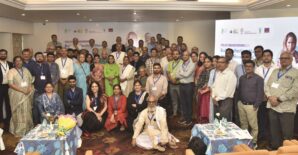Russia’s invasion of Ukraine in February 2022 sent a shock through global fertilizer markets. All agricultural trade in the region was disrupted for a time, and a number of countries imposed economic sanctions on major fertilizer producers Russia and its ally Belarus (the latter already targeted pre-invasion by European Union fertilizer export sanctions). Prices spiked, resulting in fears of widespread impacts on agricultural production. Since then, fertilizer prices have fallen from those initial highs and new trade routes and patterns have emerged.
With the Russia-Ukraine war now into its third year, this post reviews how fertilizer trade has adjusted in 2023 following those initial market disruptions. We focus on the evolution of fertilizer exports from Russia and Belarus—together they accounted for 40% of global potash trade in 2020, while Russia accounted for 16% and 12% of global nitrogen and phosphate trade, respectively.
We also look at how other major producing countries of nitrogen, phosphate, and potassium (NPK) have fared in terms of their exports and point to some shifts in import patterns of major fertilizer importing countries, examine ongoing shifts in fertilizer export trends. We do not present comprehensive information about fertilizer imports in smaller markets, in particular in Africa, given the paucity of data, but we hope to explore this topic in a future post.
Trade data from 2021-2023 shows that Russia has increased exports of all major types of fertilizers with the exception of anhydrous ammonia: In 2023, potash, urea, and diammonium phosphate (DAP) exports were all up over 2021 (as collected from mirror import data from the largest importers of Russian fertilizers). Not surprisingly, Belarus’ share of global phosphates has shrunk, but it has seen a dramatic expansion of potash exports to China. Notably, Chinese exports of phosphates have rebounded in 2023, following a dramatic decrease in 2021.
Potash (K)
The Russian share of world potash exports increased to 20% in 2023, while Belarusian potash lost half of its global market share (Figure 1). Canada remains the world’s largest exporter, but the share of global exports that it gained in 2022 shrank to 42% in 2023. Other producers (Rest of the World) have increased their combined market share from 20% in 2021 to 29% in 2023.
Figure 1

Comparing imports of Russian potash by major fertilizer importing countries, Russia has slightly increased its share of Brazil’s imports from 27% in 2021 to 29% in 2023; maintained a share of 9% of U.S. potash imports; and seen a decline in Chinese imports from a 29% share in 2021 to 26% in 2023. Most noteworthy, however, is the dramatic growth of Russia’s import share in India from a mere 4.4% in 2021 to 29% in 2023 (Figure 2).
Figure 2

Belarus, on the other hand, saw its share of potash exports to several major markets fall—not unsurprising, given the EU sanctions and the loss of access to its traditional trade route through the Lithuanian port of Klaipėda. However, thanks to transshipments through Russia, Belarus was able to continue exporting. Its share of Brazilian imports fell from 18% in 2021 to 8% in 2023, and it lost its 5% share in U.S. imports as well as its 31% share in India’s imports. It did manage to increase its share of the Chinese imports from 22% in 2021 to 29% in 2023 (Figure 3). Considering that China’s overall potash imports increased by more than one third over 2021, Belarus’s share has undergone a significant expansion. This has been facilitated by a significant increase in rail shipments of Belarusian potash through Russia to China.
Figure 3

Canada, the other major global potash supplier, saw an expansion of its share of Brazilian imports from 32%-36%; increased its share in U.S. imports from 80%-88% and its share in India’s imports from 23%-35%; but witnessed a decline of its share in Chinese imports from 28%-17%.
All other potash suppliers (Rest of World) collectively increased their combined market share in Brazil’s imports from 32%-36%, expanded their market share of Chinese imports from 21%-29%, but decreased their share in India’s imports from 42%-36% and became an even more marginal supplier of the U.S. market in 2023.
Phosphate (P)
The 2023 market shares of top phosphate producers (Morocco, China, Russia, the U.S., and other producing countries grouped under Rest of World) did not fundamentally change from 2021 (Figure 4).
Figure 4

Notably, however, Russia’s market share expanded by 3% over 2021, as it increased total DAP exports by some 70,000 nutrient metric tons (MT). Its share of India’s DAP imports increased from 2% in 2021 to 10% in 2023, and it did not see a dramatic decline in its share of EU’s imports, going from 29% in 2021 to 26% in 2023 (fertilizers are exempted from EU sanctions).
Chinese DAP exports, meanwhile, rose in 2023 over 2022, but still remained below 2021’s high levels (Figure 5). As China eased its export restrictions/licensing requirements in 2023, it had a 20% share of Brazil’s DAP imports, up from 14% in 2022, yet below the 2021 figure of 27%. China also dramatically increased its share of Indian DAP imports from 19% in 2022 to 39% in 2023, surpassing the 37% share it held in 2021.
Figure 5

Morocco’s overall share in phosphate trade decreased by 4% from 2021. Its share of India’s DAP imports decreased from 21% to 13%—compensated for to some extent by a 2% increase in EU imports and a 5% increase in Brazil’s imports.
The Rest of the World saw an overall 2% increase in its combined share of global phosphate trade, but saw a decline in combined DAP import share in Brazil, India, and the EU.
Nitrogen (N)
The global nitrogen trade is the only market where the Russian share shrank between 2021 and 2023—from 16% to 12% (Figure 6).
Figure 6

While Russia managed to export more urea in 2023 compared to 2021 by channeling exports from Russian Black Sea and Baltic Sea ports, this was more than offset by a dramatic reduction of anhydrous ammonia (AA) exports (Figure 7). Historically the largest exporter of anhydrous ammonia, Russia did not see these rebound in 2023, as exports fell by close to 3 million MT from 2021, hampered by the closure of the Togliatti-Yuzhny ammonia pipeline running through Ukraine to the port of Odesa, which served as a major trade route for Russian AA prior to the war. [Russia's exports of ammonium nitrate declined by 45% in 2022 but rebounded significantly in 2023. Urea exports from Egypt, Nigeria and the U.S. rose almost 50% in 2023 over 2021.
Figure 7

Possible changes (Russia, Belarus, China) in 2024
Given Russian announcements that it will stop discounting fertilizers and sell at market prices, the country may be facing declining global market shares for all three nutrients. However, a new ammonia terminal under construction in southern Russia on the Black Sea (Taman Peninsula), could serve as an alternative trade route beginning in 2024, boosting ammonia exports and leading to an increase in overall exports of nitrogenous products.
A new rail bridge being constructed between Nizhneleninskoye, in far eastern Russia, and Tongjiang in China’s Heilongjiang province may help sustain or further increase exports of potash from Belarus to China, but transit costs by rail remain high and Russian potash exporters may want a greater stake in the Chinese market.
While China increased its exports of nitrogenous and phosphatic fertilizers in 2023 over 2021, a new urea export ban announced in December 2023 to run through at least April and new export quotas for phosphate may reverse this trend.
What about African imports?
During the fertilizer price spikes following the invasion of Ukraine, we pointed to the vulnerability of the many African nations heavily dependent on fertilizer imports. While we lack sufficient data to paint a comprehensive picture on shifts in African imports, import data for DAP imports into Kenya and urea imports into South Africa offer some insights.
Kenyan DAP imports (Figure 8) dropped from 2021 to 2022, then was partially recovered in 2023, though all DAP last year originated from only two countries. Saudi Arabia increased its DAP market share from 75% in 2021 to 83% in 2023, while Morocco went from 13% to 58% and back down to 17% in 2021,2022, and 2023, respectively. Russia, which held an 11% market share in 2011, exported no DAP to Kenya in 2022 and 2023.
Figure 8

A rather different picture emerges from South Africa’s urea import data (Figure 9), which shows an increase in imports from Russia over the past two years (Figure 7).. Total urea imports fell 16% in 2022, but recovered significantly in 2023.
Figure 9

Conclusions
Overall, the data shows that producers in the “Rest of the World” have managed to increase their market share in N, P, and K. If this uptick from relatively small producers (notably Nigeria, Egypt, Jordan, and Israel) can be maintained, that is good news—it would diversify exports to a greater number of countries.
But it remains difficult to get new producers online, given the costs of constructing new plants and mines and now relatively lower fertilizer prices. Phosphate and potash stocks are concentrated in certain geographic regions, limiting greater diversification in P and K. The nitrogen sector includes a greater number of producing countries, but competitiveness is constrained by natural gas prices, which differ across key regions.
A newer class of “green” fertilizers is generally heralded as providing important sustainability benefits, such as reduced greenhouse gases from fertilizer production and application (see, for example, the CGIAR report Achieving Agricultural Breakthrough). Significantly ramping up production and use of such fertilizers could also have the added benefit of greater diversification of producers and exporters. Expanding production of “green ammonia”—produced through electrolysis powered by renewable energy—would help to break the industry reliance on fossil fuels for both power generation and nitrogenous fertilizers. Such a move could not only significantly reduce greenhouse gas emissions from ammonia production, but might also bring in new producers. Scaling of some regenerative agricultural practices, such as composting and crop rotation, and the use of nitrogen fixing bacteria as microbial fertilizers, would also lead to such dual benefits,
The 2022 fertilizer price spike, on top of already increasing prices, exposed the vulnerability of import-dependent countries to trade shocks. So far in 2024, fertilizer prices are significantly lower than in 2022 and 2023—but a relatively small number of large producing countries continue to dominate global exports. Along with the relatively slow progress of green alternatives, this means importers remain vulnerable to future shocks. The Israel-Hamas war and associated tensions in the Middle East—an important N producing region—could potentially deliver the next fertilizer trade shock: Multiple attacks on freight carriers passing through the Red Sea, a busy trade route for fertilizers, have already occurred—and the first cargo ship to sink, following a February attack by Yemen’s Houthi rebels, happened to carry fertilizers.
Charlotte Hebebrand is IFPRI's Director of Communications and Public Affairs; Joseph Glauber is a Senior Research Fellow with IFPRI's Markets, Trade, and Institutions Unit. Opinions are the authors'.
This post was first published here.



